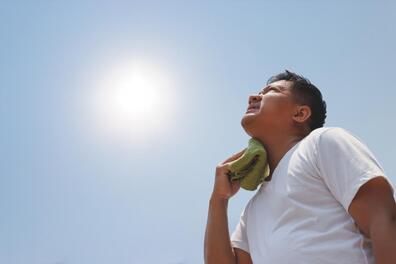Heat-Related Illnesses – What To Watch Out For?
May 9, 2022
Written by
Neha Jayaram, Communications and Marketing Specialist

Did you know your body is a lot like the thermostat in your house?
It works very hard, all day long to make sure you never get too hot or too cold. Most days, it’s pretty good at keeping your body’s internal temperature at a healthy 37°C. In the summer though, it may run into some trouble.
In 1965, Canadian meteorologists developed the Humidex, a parameter that combines temperature and humidity to reflect the “real-feel” temperature. On days when the Humidex level is really high, your body has to work extra hard to stay cool and that may cause it to malfunction.
Heat-related illnesses like heat exhaustion and heat strokes can be dangerous. People who do a lot of outdoor physical activity, seniors, children, pets and those on medications that increase their sensitivity to high temperatures.
Humidex and Degree of Comfort
Humidex
20 – 29 | Little Discomfort
30 – 39 | Some Discomfort
40 – 45 | Great discomfort; avoid exertion
46 and over | Dangerous; possible heat stroke
What is head exhaustion? How do you recognize the warning signs?
Heat exhaustion is a precursor to heat stroke and happens when the body is overheated. Your blood pressure is be low and the heart isn’t pumping blood efficiently. Some warning signs to look out for are:
- Heavy sweating
- Rapid pulse
- Dizziness/Fainting
- Fatigue, cool, moist skin with goose bumps when in the heat
- Muscle cramps
- Nausea and
- Headache.
These symptoms can come on suddenly or develop over time. They usually show up during or following periods of prolonged exercise outdoors.
What to do if you think you might have heat exhaustion?
Move yourself or the person to a cool place and remove as many pieces of clothing as possible. Place cool wet cloths on your body or if possible, take a cool bath. If the symptoms prolong seek medical help immediately.

Heat Exhaustion
- Faint or dizzy
- Excessive sweating
- Cool, pale, clammy skin
- Nausea or vomiting
- Rapid, weak pulse
- Muscle cramps
What to do:
- Get to a cooler, air conditioned place, and rest
- Drink water if fully conscious
- Take a cool shower or use cold compresses
Heat Stroke
- Throbbing headache
- No sweating
- Body temp. about 104° Red, hot, dry skin
- Nausea or vomiting
- Rapid, strong pulse
- May lose consciousness
What to do:
- Call 911
- Take immediate action to cool the person until help arrives
What is a heat stroke? Is it dangerous?
A heat stroke is the most dangerous heat related illness and is a medical emergency. When the symptoms of heat exhaustion aren’t addressed it can lead to a heat stroke. Without emergency treatment, heat strokes can lead to death.
When the body’s temperature goes about 40°C, it loses the ability to regulate its temperature.
Symptoms to be aware of are:
- Hot and dry skin
- Fast and strong pulse
- Headache
- Dizziness
- Nausea
- Confusion
- Loss of consciousness.
Heat stroke can be fatal. Your brain, heart, kidneys and muscles can become damaged, cell death can occur, all of which are serious complications and can kill you. Call 911 immediately if you suspect a heat stroke.
